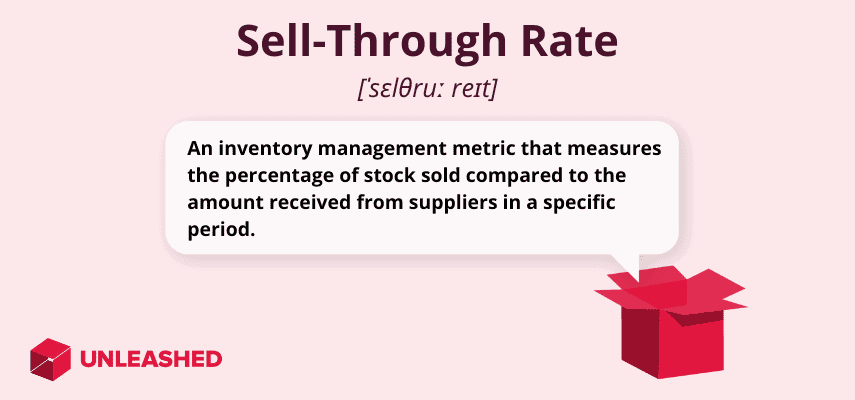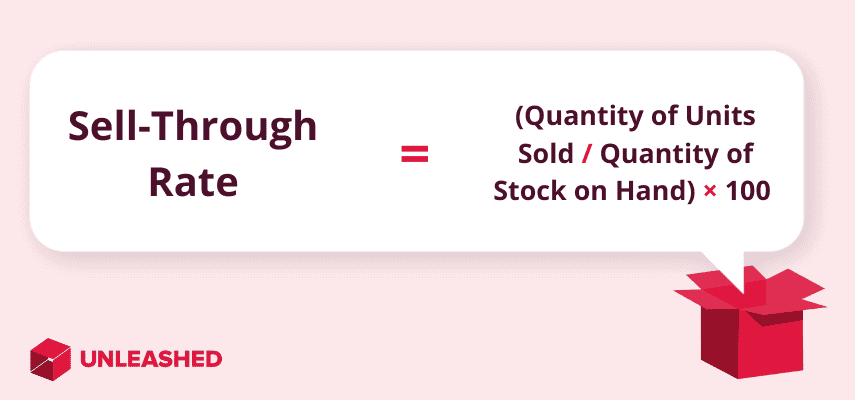
The sell-through rate metric can help you predict demand for your product by telling you how much of your purchased inventory is being sold within any given period.
Tracking your sell-through rate enables better-informed decision-making around planning for production, purchasing, and inventory management. It also helps ensure you have adequate stock to meet consumer demand without overinvesting in goods that sit unsold in your factory or warehouse.
Here’s what you need to know.
What is sell-through rate?
Sell-through rate is an important key performance indicator (KPI) in retail, manufacturing, and inventory management that measures the percentage of inventory sold compared to the amount received from suppliers within a specific period. It can help you understand how quickly goods are moving from your shelves into customers' hands.
This metric is vital for product businesses, as it helps identify sales trends, manage inventory levels, and maintain an efficient supply chain. Regularly calculating and analysing your sell-through rate means you can make better decisions about product ordering, promotions, and markdowns to optimise inventory and improve profitability.
A high sell-through rate indicates a healthy inventory turnover in alignment with consumer demand. A low sell-through rate may suggest you are overstocking, and holding too much inventory, which leads to increased storage costs and reduced cash flow.

Sell-through rate vs inventory turnover
Sell-through rate and inventory turnover are both important inventory management metrics. Though similar, they measure different aspects of controlling stock in a business.
Here’s the difference:
- Sell-through rate focuses on the quantity of stock sold within a specific period, usually calculated monthly. It measures the percentage of inventory sold compared to the amount received within a given time and reflects how well products move through your inventory.
- Inventory turnover indicates how quickly inventory is sold and replaced, usually over 12 months. This ratio measures how quickly you go through a product and shows how efficient your sales and stocking strategies are, impacting decisions related to pricing, purchasing, and manufacturing.
Both metrics are vital for maintaining a balance between having enough stock to meet customer demand and reducing excess stock that ties up capital and incurs storage costs.
Why is sell-through rate an important metric to track?
The sell-through rate is a crucial metric it helps you understand the demand for your products and whether you are purchasing the right quantities from suppliers, which is vital for maintaining a balance between supply and demand.
Tracking your sell-through rate also provides an opportunity to optimise your supply lines and manage cash flow to ensure you aren’t tying up too much capital in unsold inventory.
Sell-through rate also provides an insight into your customers’ preferences, allowing you to undertake more targeted marketing and product development strategies.
A healthy sell-through rate indicates that a product is popular and selling well. It can inform future purchases and help you avoid overstocking, resulting in lower carrying costs and greater profits.
What is a good sell-through rate?
A widely accepted benchmark for a good sell-through rate is at or above 80%, although this can vary depending on the industry and product category. Achieving a high sell-through rate shows that your inventory is turning over efficiently, meaning that your products are in demand and your stock levels are well-matched to your customers’ buying patterns.
Conversely, a low sell-through rate can signal overproduction, poor market demand, or ineffective sales strategies. You want to improve your sell-through rate to avoid overstocking and the associated costs, optimise supply chain management, and improve your cash flow.
How to calculate sell-through rate
Calculating sell-through rate is a straightforward process that can provide valuable insights into inventory management. Sell-through rate is the percentage of inventory sold compared to the amount received during a specific period. It’s often used in retail and ecommerce to gauge product demand and inventory turnover.
First, determine the number of units sold during the period to calculate your sell-through rate. Then ascertain the quantity of stock on hand at the beginning of the period. Finally, use the sell-through rate formula below to determine your rate.
Sell-through rate formula
The sell-through rate formula is a crucial metric in inventory management. It represents the percentage of inventory sold compared to the amount available at the start of a period.
To calculate your sell-through rate, divide the number of units sold by the quantity of stock on hand at the beginning of the period, then multiply by 100 to get a percentage.
The sell-through rate formula can be expressed as:
(Quantity of Units Sold / Quantity of Stock on Hand) × 100 = Sell-Through Rate
For example, if you started with 500 units of on-hand stock and sold 200 of them, the sell-through rate would be:
(200 ÷ 500) × 100 = 40%
This calculation helps businesses understand the demand for their products and manage inventory levels effectively, ensuring they can meet customer demand without overstocking.

How to improve sell-through rate
Improving sell-through rate can help you optimise cash flow, lift business efficiency, and minimise waste in your operations. By implementing any or all of these strategies, you will not only improve your sell-through rate but also enhance customer satisfaction and loyalty – ultimately contributing to your long-term business success.
Each tactic should be tailored to the specific context of your business and continuously refined based on performance data and customer feedback. The key to improving sell-through rate lies in understanding and quickly adapting to both customer needs and market dynamics.
1. Understand your customer
Deep analysis of customer data can reveal insights into shopping habits and product preferences, which can inform inventory selection and marketing strategies.
For example, understanding customer demographics, behaviours, and purchasing patterns can lead to more tailored inventory and marketing approaches, optimising the alignment of product offerings with customer demand.
Improve your product presentation and store layout by enabling endless aisle shopping.
By leveraging store fulfilment options and offering retail promotions you gain effective strategies that not only improve your sell-through rate but also enhance the overall customer experience, leading to increased customer satisfaction and loyalty.
2. Enhance inventory management
Regularly review and adjust inventory levels to ensure they align with current market demand.
To improve sell-through rate, it's crucial to implement a dynamic inventory management strategy that involves regular analysis of sales data, market trends, and seasonal fluctuations to make informed decisions about stock levels. By doing this, you can maintain an optimal balance, ensuring that high-demand items are readily available while reducing the risk of excess inventory that can lead to markdowns or waste.
Consider leveraging technology to automate inventory processes, with software systems that can provide real-time insights and alerts when stock levels need adjustment. This proactive approach not only improves the sell-through rate but also maximises profitability and customer satisfaction because it ensures that popular products are in stock when your customers are ready to make a purchase.
3. Optimise product presentation
Invest in high-quality images and compelling product descriptions to make items more attractive to potential buyers. This can significantly make items more eye-catching to potential buyers.
4. Adjust pricing strategically
Implement dynamic pricing strategies that reflect the value perceived by customers and the competitive landscape. Dynamic pricing strategies are essential for businesses that want to stay competitive and maximise profits.
By adjusting prices based on real-time market demand, you can more accurately reflect the value perceived by customers. This approach takes into account factors such as competitor pricing, supply and demand, and inventory levels.
Utilising data analytics allows you to effectively deploy sophisticated algorithms that analyse market conditions and predict optimal pricing. This strategy has been successfully implemented by airlines for years and more recently by ride-sharing companies to balance supply and demand, adapting prices in response to market fluctuations.
A dynamic pricing strategy enhances market adaptability and ensures that you can respond quickly to changes in the competitive landscape.
 Improving sell-through rate can help you optimise cash flow while simultaneously improving the experience for your customers.
Improving sell-through rate can help you optimise cash flow while simultaneously improving the experience for your customers.
5. Leverage promotions
Use targeted promotions to create urgency and encourage purchases, especially for slow-moving items.
Targeted promotions are a strategic approach to stimulate consumer interest and improve product turnover, particularly for items that do not sell quickly. By creating a sense of urgency through limited-time offers or exclusive deals, you can motivate customers to make a purchase sooner rather than later.
This tactic can be particularly effective when applied to slow-moving stock, as it helps to clear out inventory and reduce holding costs. Personalised promotions – based on customer purchase history or preferences – can significantly increase the effectiveness of such campaigns, leading to higher conversion rates and customer satisfaction.
Implementing these strategies requires careful planning and analysis of consumer behaviour to ensure that the promotions reach the right audience and achieve the desired outcome.
6. Improve store layout and design
A well-organised store layout can enhance the shopping experience and make it easier for customers to find and purchase products. A well-thought-out store layout is crucial for any retail business. It affects the overall shopping experience and influences customer behaviour and store profitability.
An effective layout is designed with the customer's journey in mind, guiding them through the store in a way that is intuitive and enjoyable. It strategically places products to catch the eye and can even encourage impulse purchases. It also ensures that best-selling items are easily accessible while providing a logical placement for all products, reducing the time customers spend searching for what they need.
This thoughtful organisation can lead to increased customer experiences, repeat business, and ultimately, a successful retail operation.
7. Use data analytics
Employ advanced analytics to forecast trends, understand sales patterns, and make informed decisions about which products to stock.
Advanced analytics have revolutionised the way businesses forecast trends and understand sales patterns. By leveraging predictive modelling, machine learning, and process automation, you can gain deeper insights into consumer behaviour and market dynamics.
This allows for more accurate predictions of future sales performance, enabling businesses to make informed decisions about which products to stock.
8. Offer multiple fulfilment options
Providing various shipping and pickup options can cater to different customer preferences and improve overall satisfaction.
Offering a range of shipping and pickup options is a strategic approach you can use to enhance customer satisfaction. By doing so, you can accommodate your customers' diverse needs and schedules and allow for greater flexibility and convenience.
Some of your customers may prefer the speed of express shipping, while others might prioritise cost-effectiveness with standard shipping options. Local pickup or collection options can appeal to those who wish to receive their products immediately without the associated delivery wait.
This level of service customisation meets individual preferences but also fosters a sense of customer care, which can lead to increased loyalty and positive word-of-mouth recommendations.
9. Conduct A/B testing
Regularly evaluate various aspects of your sales and marketing approach to determine what works best for your audience and adjust accordingly.
Testing various components of your sales and marketing strategy is crucial for understanding your audience's preferences and behaviours. It's a dynamic approach that keeps your business agile and client-driven. This process, often referred to as A/B testing or split testing, involves comparing two versions of a campaign to see which one performs better.
By analysing the results, you can gain insights into the most effective messaging, design, and channels for your target market. Regular testing and adaptation not only optimises any current campaigns but also helps to inform future strategies, ensuring that your marketing efforts are always evolving to meet the needs and interests of your audience.
